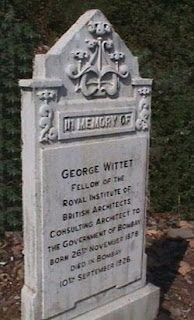 |
| Scottish architect George Witte artdecomumbai.com |
 |
| Tomb of Architect George Witte, Mumbai findagrave.com |
More than 96 years ago, on 10 September 1926, Bombay lost its most famous Architect George Witte (1878-1926) at a young age of 48. Born in 1878 in Scotland he came to Bombay in 1904 as an assistant to John architect John Begg, then Consulting Architect to Bombay. He studied architecture with a Mr. Heiton of Perth, Scotland, and having worked in Edinburgh and later with Walter Henry Brierley of York, he began his career in Bombay
Witte and Begg were responsible for the evolution and subsequent popularity of the Indo-Saracenic Style of architecture in this part of India . Robert Chisholm, British architect in the Madras Presidency was the one who introduced this design style mixing Hindu and Muslim design elements in many building in Madras (now Chennai). On 12 May 1917, Consulting Architect to the Government of Bombay, Witte was unanimously elected as the first President of The Indian Institute of Architects.
Whitte's vast contribution included many well-designed structures that are some of Bombay's best-known landmarks: the Prince of Wales Museum, the Gateway of India, the Institute of Science, the Small Causes Court at Dhobitalao, the Wadia Maternity Hospital, Bombay House, the King Edward Memorial Hospital, and The Grand Hotel and other buildings at the Ballard Estate, by the Bombay Docks. Among them the Gateway of India, Mumbai (or Bombay, as it was then), was the most famous colonial site by Witte which still stands as a legacy of British Crown rule in India.
The foundation stone of this iconic and world-famous structure was laid in 1913, and the work on it was completed in 1927. Witte had this structure built of yellow basalt (locally available) and concrete on the Apollo Bunder, Mumbai, It was meant to commemorate the visit to India of King George and Queen Mary for the 1911 Delhi Durbar.
According to architect Preeti Chopra the Gate Way of India was not just a portal, but "served as a reception hall and consisted of three domed spaces: a central hall with massive arches that formed the gateway, flanked by side halls that could accommodate up to six hundred people" Witte was also responsible for the plaster structure through which King George and Queen Mary had passed in 1911, after they disembarked from their ship in 1911, touching Indian soil for the first time. The Gateway, built specifically in memory of this occasion was to be a permanent arrival point. They were on the way to attend the 1911 Delhi Durbar, held on December 12, 1911 to mark the coronation of King George V and Queen Mary as Emperor and Empress of India. It was the third and last of a series of formal coronation events held by the British Raj in India. The event was attended by many prominent British officials and the heads of princely states cost around one million pounds to showcase the British Supremacy.
Dubbed as the largest extravaganza show in the world (at the expense of British India government), a ceremony of pompous and pageantry while the native subjects were suffering from abject poverty and clamoring for freedom from the unjust British rule.
George Witte died in Bombay where he had begun his career and the cause of his death was due to Dysentery. Unfortunately, the graveyard where he was buried is in poor shape, not well-kept. Also buried here is yet another British architect Frederic William Stevens who designed Victoria Railway Terminus in the prime area of Mumbai. This graveyard- Sewri Christian Cemetery in Sewri, one of the oldest in Asia, has tombs of many prominent Indian and European citizens.
Called Sewri Christian Cemetery in Sewri, Mumbai, India, it was was established by Arthur Crawford, the first Municipal Commissioner of Bombay as a location for European burials.
https://www.navrangindia.in/2022/06 George Witte - prolific Scottish architect of British India
https://bijoor.me/2017/06/17/mumbai-heritage-architects-graves-monuments/
http://timesofindia.indiatimes.com/articleshow/28693486.cms?









